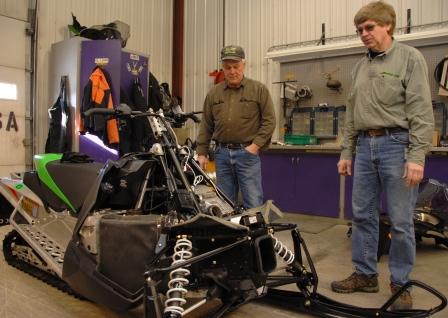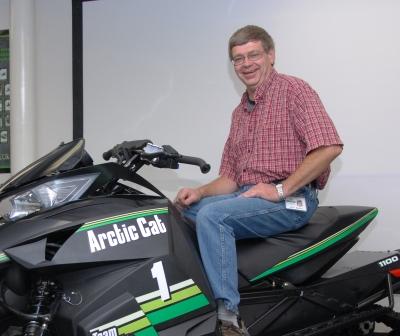
Great snowmobile designs like the new 2012 Arctic Cat F, XF and M models are the result of a dedicated design process that starts with artistic renderings, migrates to CAD drawings and is eventually made from production tooling. But along the way, full-scale models are produced to assist the product planning team to evaluate the “shape” of the sled while it’s still in the design phase.
Jack Nelson (53) is the person at Arctic Cat whose job it is to construct those prototype models. It’s a job he’s performed in once capacity or another for more than 35 years.
Good-natured, dedicated and passionate about his job, Nelson has played a role in the shape of snowmobiles ranging from the 1970s el tigres to the ZRs, Crossfires and the new 2012 Arctic Cat snowmobiles.
He was kind enough to answer a few questions about his role in Engineering.
AI: Okay Jack, tell us what your job title is, and what it is that you actually do.
Nelson: I’m a Styling Engineer in the Plastics Group. My role is to build models of new snowmobile components for styling review. I also work on some ATV modeling, but mostly I’m focused on snowmobiles.
AI: AI: What parts of the snowmobile do you work on?
Nelson: I focus on all the parts we call the “skin,” which is the hood, bellypan, windshield, fuel tank, seat and snow flap.

AI: Are you someone who creates the actual designs?
Nelson: No, I’m the person who takes the design, in the form of a CAD file, then actually constructs the component using some form of modeling medium, such as foam, clay, plastic and such.
So in the case of the F4 (the project name given to the 2012 F, XF and M sleds) that you have pictures of, I took the design files given to me by the designer, Nathan Blomker, and I used the tools I have to construct a life-sized mock-up of the machine.
Much of what you see on the model is foam that was cut on a giant mill, but some of it is also made from cardboard, body putty, plastic and clay. Foam is the most common material we use, because it’s easy to work with and very stable. But there are days when I’m just as likely working a rattle-can of paint as I am building snowmobile skin from foam.
In many ways, what I do is just like bodywork on automobiles.

The purpose of creating models like the one you see is for styling confirmation review when we’re developing new skin. Seeing a full-sized machine in three dimensions gives people a perspective that’s not possible if they’re looking at a drawing or even a scale model.
AI: You’ve been working in Styling building prototypes for a lot of years.
Nelson: I started working for Arctic Cat in 1975, making patterns and molds for hoods, seats, fuel tanks and such. I was 18 when Kenny Halvorson hired me, the first project I worked on was the skin for what would become the 1978 el tigre, and I’ve been happy ever since.
AI: How different is what you do today, compared with 30 years ago?
Nelson: Back in those days we would literally construct a component on a table using various materials, then start shaping it until we arrived at a final design shape that everyone was happy with. We started with drawings, but they were artist renderings, rather than actual three-dimensional prints, and the shapes would change significantly during the modeling phase.

AI: What are the aspects of your job that you enjoy the most?
Nelson: Definitely the variety and the people.
I get to work on seats, bellypans, hoods and such in a very hands-on way. They’re fun products – snowmobiles and ATVs – and I work with fun people. The team effort that all comes together to produce something like our new 2012 sleds is very satisfying, which is another great aspect of my job.
We’re always excited about new products, and it’s enjoyable for me to see the new stuff and work on it years before it becomes public.
AI: I suppose that when the world got to see the new 2012 snowmobile line in early March that they were already old for you.
Nelson: The look of the machines was definitely not new to me at that point, but seeing the reactions of our dealers and customers is one of the most enjoyable parts of my job. Everyone here works very hard to design and build these machines, and when our customers like what we do, it’s tremendously gratifying.
But you’re correct that in my job, I’m usually working on projects that are 1-4 years from production.
Every once in a while I have to stop and think, “What year are we in?” Because the calendar year might be 2010, the pieces I’m working on that day are 2012 models, yet we might also be starting on another project that’s for 2014. So it can get a little confusing sometimes (laughter).
AI: What are some of your favorite sled designs/shapes from over the years?
Nelson: I really like the original ZR (pause) and the Crossfire. Those are two of my favorites.
AI: Do you own a snowmobile?
Nelson: I have a 2002 ZR 800. I like the big-twin power and ride quality of that sled.
AI: Thanks for taking the time to talk with me, Jack. I think you have a really cool job.
Nelson: You’re welcome. I enjoy talking about my job because I agree, it is really fun.



Jack is a class act…always a smile on his face.
These are the real people behind the sleds we love. Keep up the info John.
Sweet! Is jack related to Garry Nelson?
COOL! would love to see that process from paper to final model, a time lapse on the actual model would be way cool… great to see CAT has real people behind the scenes and that Arctic Insider is shedding some light on the fabrication process! Awesome!
Agree with you artdcat, Jack is absolutely a class act.
Blake: I don’t believe that Jack and Gary are directly related, but perhaps distantly. I’ll find out.
Jack is a great guy and a big time backcountry rider. Thats what I love about Cat, the employees get out and ride. They really know what it takes to build a great sled. Keep up the great work Jack. Hope to see around fourtown or out in the swamps. Rob
Jack, we all appreciate your dedication to arctic Cat and your craftsmanship! Cheers to you for the great looking 2012 Arctic Cats! In my eyes, Cat’s finest offering to date. I know you are probably working on future stuff that is even better!
Looking good, Jack! And to think you even have spare time to be the president of our Fourtown/Grygla Sportsman’s Club. Uffda!
That was a great peice. What a great guy and a testament to the reason Cat is the best…because of the people behind the sleds.
Bleed green and love it.
Thanks for the great info John.
Jack is also an excellent mechanic. He can fix most anything. Handy to have along on our annual Club trail ride.
Awesome read about yet another passionate Cat employee!
John, any insight into what motor is in that sled depicted in the last pic? Or is that something for a “future story”? LOL
Hey John, What motor is in that last picture ?? Doesnt look like the 800, or 1100. Care to elaborate.
Nice work Jack!! Now scalp the sunsa*****es who made it a 20min job to check our coolant.